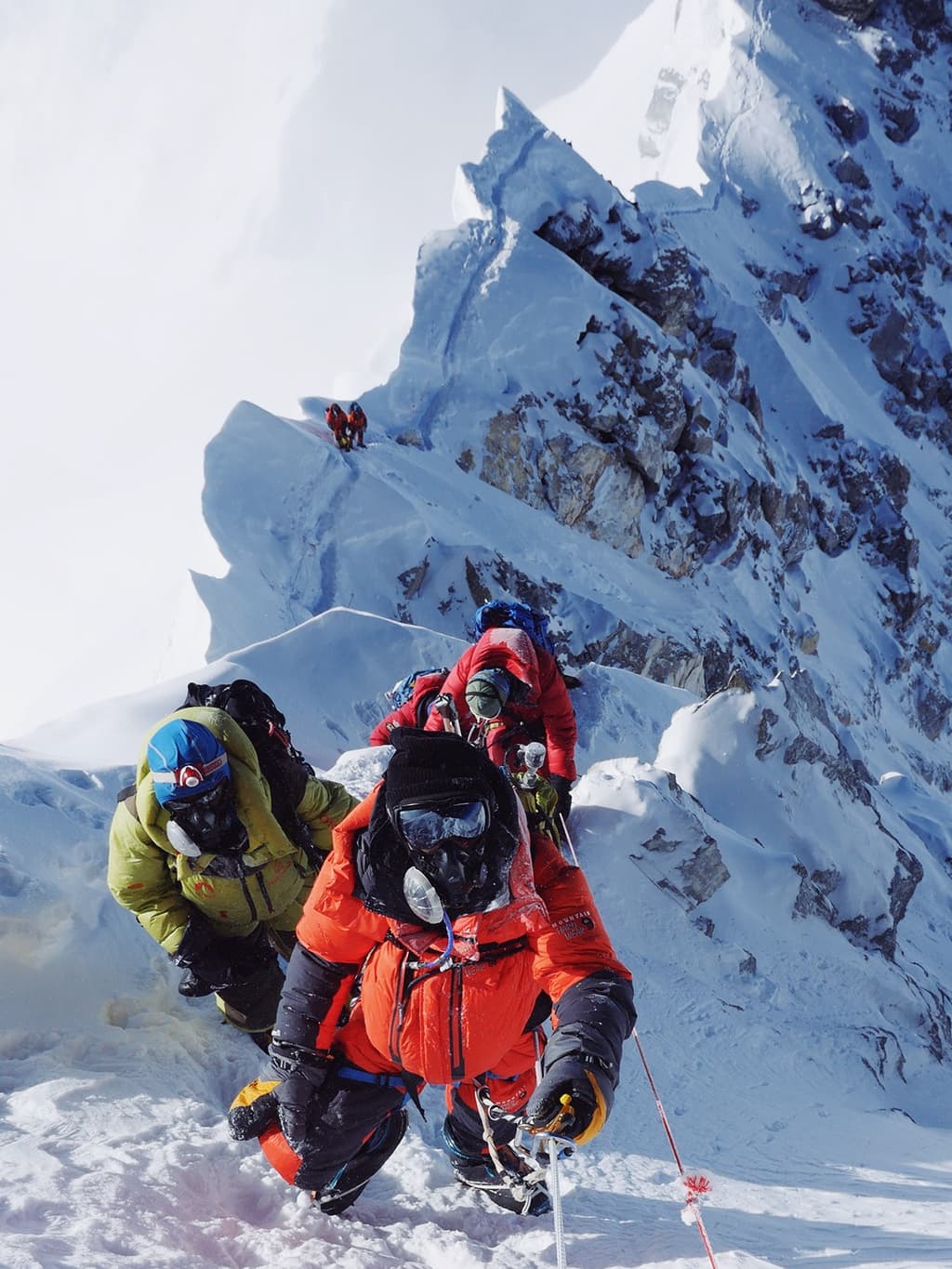Ever imagined standing at 8,163 meters, breathing air so thin it feels like you're drowning, while staring at a panorama that makes your knees weak? That's Manaslu – the eighth highest mountain on Earth and possibly Nepal's best-kept mountaineering secret.
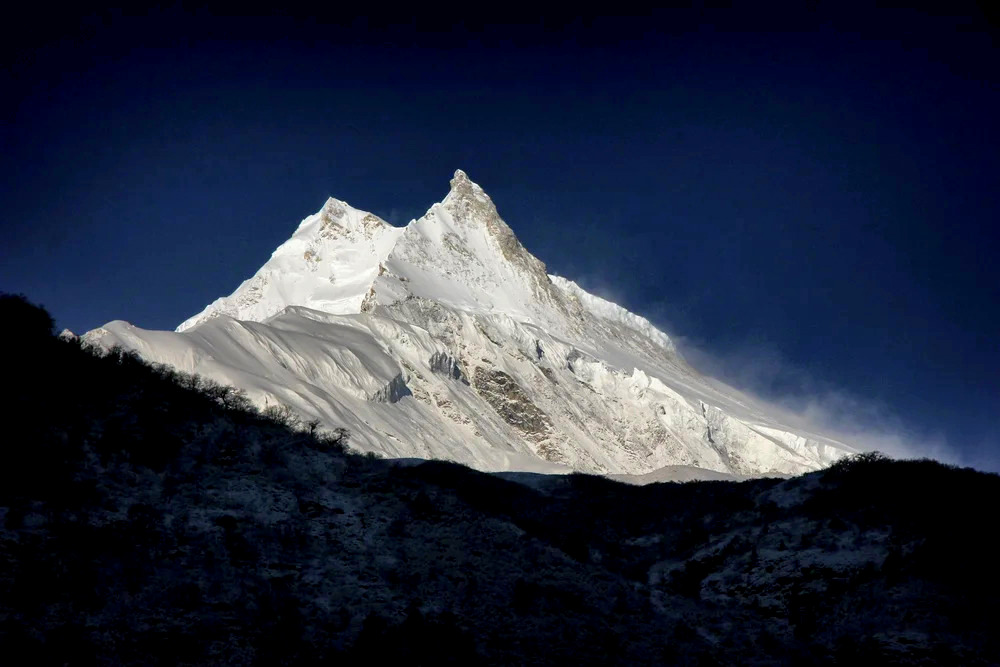
For serious climbers looking beyond the Everest circus, a Manaslu expedition offers that perfect balance of extreme challenge and spiritual journey. The "Mountain of the Spirit" isn't just another peak to bag – it's a less-crowded alternative that still demands everything you've got.
But here's what they don't tell you in the brochures: the real magic of Manaslu happens long before you reach the summit. And that's where most expedition planners get it completely wrong...
Overview of Mount Manaslu: The Eighth Highest Peak
Geographic location and unique features
Nestled in the Mansiri Himal region of Nepal, Manaslu stands tall at 8,163 meters (26,781 feet), making it the eighth highest mountain in the world. We've always been amazed by its distinctive horseshoe shape that dominates the landscape. The mountain sits about 64 km east of Annapurna, creating a breathtaking panorama that few other places on earth can match.
The name "Manaslu" comes from the Sanskrit word "Manasa," meaning "mountain of the spirit" - and trust us, once you see it, you'll understand why. The mountain features four faces and three ridges, offering various climbing routes with different levels of difficulty.
What makes Manaslu truly special is its diverse ecological zones. As we trek from the base to the summit, we pass through tropical forests, alpine meadows, and finally the harsh arctic conditions near the peak. The mountain is surrounded by the Manaslu Conservation Area, home to rare species like the snow leopard and red panda.
Historical significance in Himalayan mountaineering
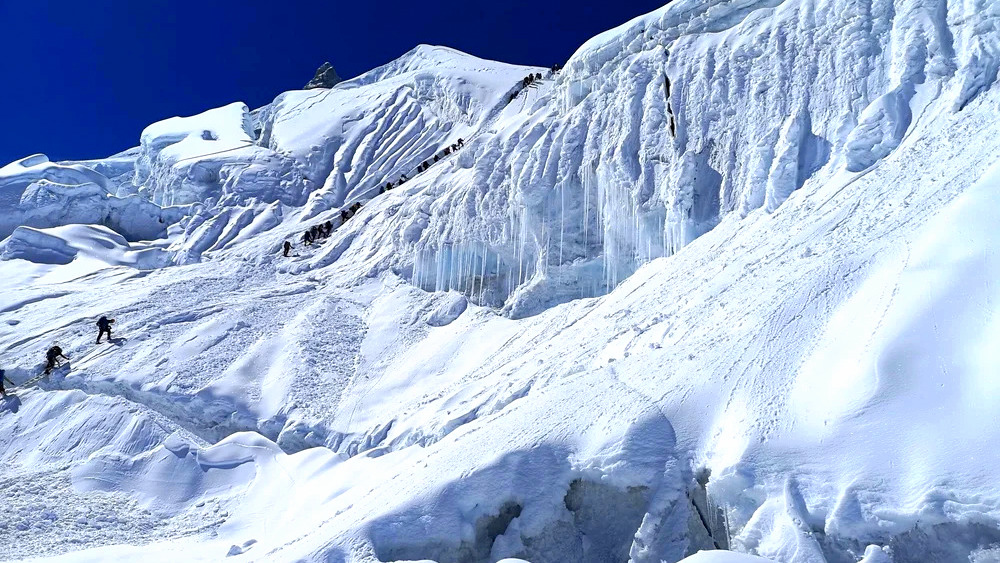
Manaslu first caught the attention of climbers in the early 1950s. Japanese expeditions made the first serious attempts, with Toshio Imanishi and Gyalzen Norbu finally reaching the summit on May 9, 1956. This established a strong Japanese connection with the mountain that continues today - many climbers still call it "Japan's Mountain."
For decades, Manaslu remained one of the less frequented 8000ers. This changed dramatically in the 2010s when we saw a surge in expeditions. The mountain has witnessed both triumph and tragedy - the 1972 avalanche that took 15 lives serves as a sobering reminder of Manaslu's power.
Unlike Everest's commercialization, Manaslu preserved its mystique longer. The mountain's climbing history reflects the evolution of Himalayan mountaineering itself - from national expeditions to today's more accessible commercial trips.
Why climbers are drawn to this "Mountain of the Spirit"
The allure of Manaslu is impossible to ignore. We find that climbers are drawn to it for several compelling reasons. First, it's technically challenging without being suicidal - offering a perfect middle ground for serious mountaineers looking to graduate to 8000-meter peaks.
The relative solitude compared to Everest is another major draw. Even with increasing popularity, Manaslu sees a fraction of the traffic that crowds the world's highest peak. This means more authentic experiences and less time waiting in lines during summit pushes.
We've also noticed climbers appreciate the cultural richness of the region. The Manaslu Circuit provides access through remote villages where traditional Tibetan Buddhist culture thrives. This cultural immersion adds a spiritual dimension to the climbing experience that many find transformative.
For those targeting all fourteen 8000ers, Manaslu represents an essential and often favorite step in their journey. Its reputation as a "honest mountain" - one that demands respect but rewards proper preparation - keeps bringing adventurers back to its slopes year after year.
Everest Sherpa Expeditions: Your Trusted Guide to Manaslu
Our experience and safety record on Manaslu
When it comes to climbing the world's eighth highest peak, experience matters. We've been guiding expeditions on Manaslu for over 15 years, successfully leading more than 200 climbers to the summit. Our safety record speaks for itself - we maintain one of the highest success-to-safety ratios in the industry.
Safety isn't just a priority for us; it's our foundation. Each expedition carries state-of-the-art communication equipment, supplemental oxygen, and comprehensive medical supplies. Our team performs daily weather checks and maintains constant radio contact between camps.
The numbers tell the story:
-
97% client safety rate
-
85% summit success rate
-
Zero major incidents in the past decade
What sets our Manaslu expeditions apart
The difference is in the details. We maintain a 2:1 client-to-guide ratio, ensuring you get personalized attention throughout your journey. Our base camp feels like home, with comfortable sleeping tents, a spacious dining area, and even hot showers.
We're also committed to responsible climbing. We carry out all waste, minimize our environmental impact, and contribute to local communities through our "Climb for Education" initiative, which has built three schools in the Manaslu region.
Our expeditions include:
-
Pre-acclimatization program
-
Custom nutrition plans
-
Professional photography
-
Satellite phone access
-
Post-climb celebration in Kathmandu
Client success stories
Emma from Australia reached the summit last season: "The team treated me like family. When I struggled at Camp 3, my guide Mingma knew exactly what to say to keep me going."
Mark, a doctor from Canada, climbed with us twice: "After comparing with other companies, I returned to Everest Sherpa Expeditions for my second 8000er. Their attention to detail is unmatched."
James, an experienced mountaineer from the UK: "What impressed me most was how they handled an unexpected storm. While other teams panicked, our guides calmly adjusted the plan, ensuring everyone's safety without abandoning summit goals."
We don't just help clients reach the summit - we help them return with unforgettable memories and a deeper connection to the mountains we call home.
Manaslu Expedition: Route and Itinerary Highlights
The Classic Climbing Route Explained
The Manaslu climbing route follows the Northeast Face, offering a challenging yet rewarding journey to the summit. We begin our expedition from Samagaon (3,530m), trekking through beautiful rhododendron forests and Tibetan villages. After establishing Base Camp at 4,800m, we navigate through a series of higher camps.
Camp 1 sits at 5,700m, requiring us to cross a glacier and navigate some technical terrain. Moving to Camp 2 (6,400m), we tackle steeper slopes and potential crevasse hazards. Camp 3 (6,800m) positions us for the final push, while Camp 4 (7,450m) serves as our launching pad for summit day.
The most challenging sections include the crevasse fields between Base Camp and Camp 1, and the steep slope approaching Camp 3. The final summit ridge demands careful navigation, but rewards with breathtaking views across the Himalayas.
Detailed Day-by-Day Itinerary
Days 1-2: Arrival in Kathmandu, preparation and briefing
Days 3-4: Drive to Soti Khola, begin trek to Machha Khola
Days 5-8: Trek through Jagat, Deng, Namrung to Samagaon
Days 9-10: Acclimatization at Samagaon
Days 11-12: Trek to Base Camp, setup
Days 13-19: Rotation through higher camps for acclimatization
Days 20-35: Summit window, climb to Camp 1, 2, 3, 4 and summit attempt
Days 36-42: Descent to Base Camp and trek back to Soti Khola
Days 43-44: Return to Kathmandu, celebration dinner
Acclimatization Strategy for Optimal Success
We implement a carefully designed acclimatization plan to maximize your summit chances. After reaching Base Camp, we follow the "climb high, sleep low" principle with several rotation cycles:
-
First rotation: Climb to Camp 1, return to Base Camp
-
Second rotation: Climb to Camp 2, sleep at Camp 1, return to Base Camp
-
Third rotation: Climb to Camp 3, sleep at Camp 2, return to Base Camp
During acclimatization days, we encourage light activity rather than complete rest. Our team monitors oxygen saturation levels regularly, adjusting the plan based on individual adaptation. We typically spend 2-3 weeks on these rotations before the summit push.
Base Camp Facilities and Services
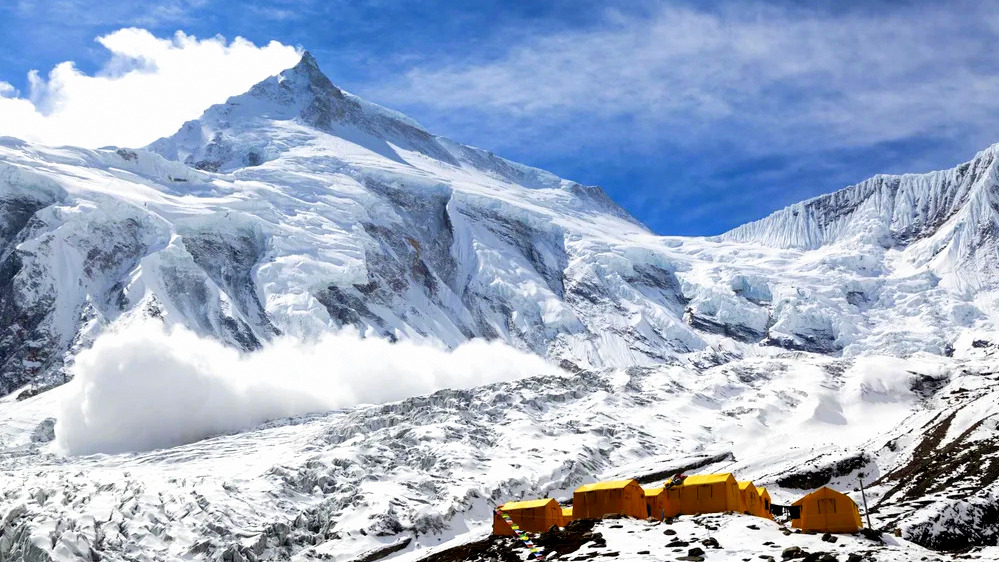
Our Manaslu Base Camp offers comprehensive amenities to keep you comfortable during your expedition:
-
Individual sleeping tents with thick mattresses
-
Spacious dining tent with tables and chairs
-
Dedicated communications tent with solar charging
-
Hot shower facilities
-
Fully-equipped kitchen with experienced chefs
-
Medical tent with emergency equipment
-
Toilet tents for hygiene and comfort
We provide three nutritious meals daily plus snacks, with diverse menu options including Western, Nepali, and Continental cuisine. Our communications setup includes satellite phones and internet access, allowing you to stay connected with loved ones. Our medical staff performs regular health checks throughout your stay.
Summit Day Expectations
Summit day begins around midnight from Camp 4. We'll equip you with summit oxygen systems, down suits, and essential climbing gear. The climb typically takes 8-10 hours to reach the top, with the most challenging sections being the steep snow slope at 7,700m and the final narrow ridge.
Weather plays a crucial role, and we constantly monitor conditions. Temperatures at summit can drop to -30°C with wind chill making it feel even colder. We maintain a strict turnaround time policy to ensure safe descent before afternoon weather deteriorates.
The panorama from Manaslu's summit is truly spectacular – views extend across Nepal and Tibet, with Annapurna, Dhaulagiri, and countless Himalayan peaks visible on clear days. After brief celebrations and photos at the summit, we begin our careful descent to Camp 4 or Camp 3, depending on timing and conditions.
Essential Preparation for Your Manaslu Climb
Physical Training Recommendations
Climbing Manaslu isn't a walk in the park - it's one of the world's toughest challenges. We recommend starting your training regimen at least 6 months before your expedition. Focus on building cardiovascular endurance through activities like trail running, hiking with a weighted pack, and stair climbing. Aim for 3-4 cardio sessions weekly, gradually increasing duration and intensity.
Strength training is equally critical. We've seen the difference strong legs and core make at high altitude. Include squats, lunges, deadlifts, and planks in your routine 2-3 times weekly. Don't forget shoulder and upper body work - you'll be thanking yourself when hauling gear between camps.
Altitude training or acclimatization hikes are golden if you can manage them. Weekend trips to elevations of 8,000-12,000 feet help your body adapt to lower oxygen levels.
Required Technical Climbing Skills
For Manaslu, we require all climbers to have mastered several essential skills:
-
Cramponing on steep ice (front-pointing technique)
-
Rope skills including ascending fixed lines with jumars
-
Ice axe self-arrest from multiple falling positions
-
Glacier travel and crevasse rescue basics
-
Experience using oxygen masks at altitude
Previous 6000m+ climbing experience is mandatory, and we strongly recommend at least one 7000m+ peak before attempting Manaslu. Many of our successful clients have previously climbed peaks like Denali, Aconcagua, or Island Peak.
Gear and Equipment Checklist
The right gear can make or break your Manaslu experience. Here's what we consider essential:
High-Altitude Clothing:
-
Down suit rated to -40°C
-
Multiple insulating layers (mid and heavyweight)
-
Windproof/waterproof shell layers
-
High-altitude boots (La Sportiva Olympus Mons or similar)
-
Multiple glove systems including summit mitts
Technical Equipment:
-
Ice axe (55-65cm recommended)
-
Crampons (compatible with your boots)
-
Climbing harness
-
Ascenders and descenders
-
Carabiners (locking and non-locking)
-
Helmet
Personal Gear:
-
Expedition-rated sleeping bag (-40°C)
-
Insulated sleeping pads
-
Headlamp with spare batteries
-
80-90L expedition backpack
-
Glacier sunglasses and goggles
We provide oxygen systems, group climbing equipment, and communications gear.
Mental Preparation Tips
The mental game on Manaslu often separates success from failure. We've guided hundreds of climbers and seen how crucial psychological resilience becomes above 7000m.
Visualization techniques help tremendously - we encourage spending time daily imagining yourself moving efficiently through difficult sections. Meditation and breathing exercises build mental endurance for those long, challenging days.
Setting incremental goals works wonders. Instead of fixating on the summit, break your climb into manageable sections. Camp-to-camp thinking keeps overwhelming moments at bay.
Prepare for discomfort. Practice spending extended periods in uncomfortable positions or environments. Those who embrace discomfort rather than fight it consistently perform better at altitude.
Finally, have your "why" crystal clear. When things get tough (and they will), a powerful personal motivation keeps your feet moving when every fiber of your being wants to turn around.
Best Seasons for Climbing Manaslu
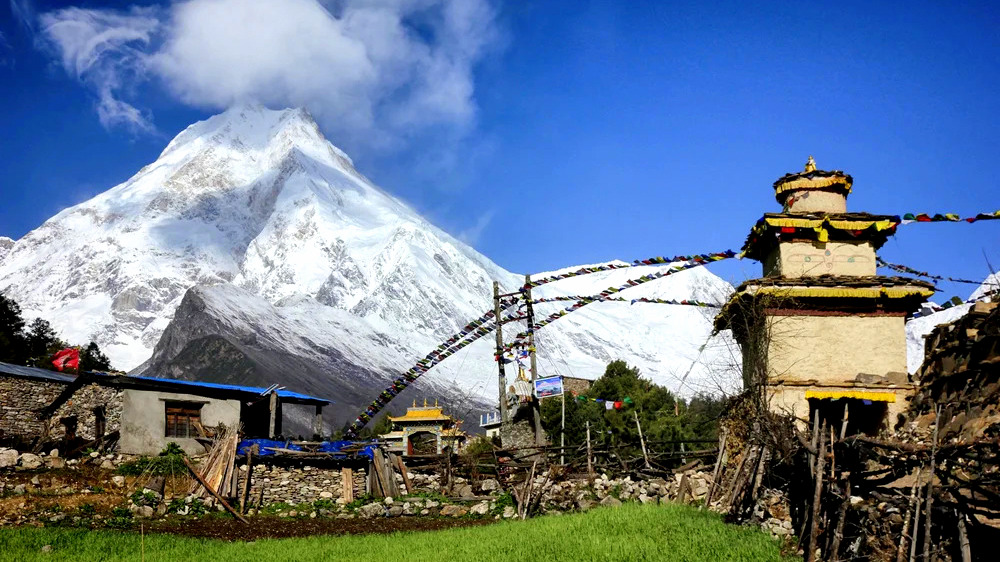
Pros and cons of pre-monsoon (spring) expeditions
Spring (March to May) on Manaslu brings a sweet spot for climbers. We've guided dozens of expeditions during this season and can tell you it's popular for good reason.
The weather stabilizes nicely after winter, with temperatures gradually warming up. Oxygen levels feel more comfortable as you ascend, and those crystal-clear mornings give us stunning views of the surrounding Himalayan giants.
But spring isn't perfect. Crowds can be an issue, especially in April when the mountain gets busy. This means potential bottlenecks at technical sections, especially above Camp 3. And don't forget - as the season progresses, temperatures rise, increasing avalanche risk from afternoon onwards.
|
Spring Pros |
Spring Cons |
|
Stable weather patterns |
Increasingly crowded |
|
Warmer temperatures |
Higher avalanche risk later in season |
|
Excellent visibility |
Potential bottlenecks at technical sections |
|
Longer daylight hours |
Unpredictable storms possible |
Post-monsoon (autumn) climbing conditions
After the monsoon clears out (usually by late September), we often find Manaslu in prime condition. The mountain gets a fresh coat of snow, temperatures are moderate, and the air feels incredibly crisp.
Autumn (October to November) typically brings more stable weather than spring. We've noticed fewer sudden storms and more consistent conditions. The mountain also tends to be less crowded, giving our teams more flexibility with acclimatization schedules.
The downside? Days get shorter as the season progresses. By early November, temperatures drop significantly, and winds pick up strength. Our summit pushes need more precise timing.
Weather patterns and success rates by season
The numbers don't lie - both seasons offer good summit chances, but with different risk profiles.
Spring success rates hover around 65-70% for our expeditions, with most summits happening in May when the jet stream moves northward. Weather windows can last 3-5 days, giving teams flexibility.
Autumn success rates run slightly lower at 55-65%, but with fewer climbers. October typically offers the most stable conditions with lower wind speeds at high altitude.
Our data shows:
-
Spring: Higher temperatures, more precipitation later in season
-
Autumn: Gradually cooling temperatures, clearer skies, increasing winds
The sweet spot? Early May for spring and early October for autumn. That's when we've had our highest success rates year after year.
Permits, Logistics and Practical Information
Required climbing permits and documentation
Getting your permits right is a must for Manaslu. We handle all the paperwork, but here's what you need to know. The main permit is the Manaslu Climbing Permit issued by the Nepal Ministry of Tourism, which costs $800 per person during autumn (September-November) and $400 during spring (March-May).
You'll also need:
-
Manaslu Conservation Area Permit (MCAP): $30
-
Restricted Area Permit: $100 per week
-
Garbage deposit: $500 (refundable)
Don't forget your passport with at least 6 months validity and 4 passport-sized photos. We recommend starting the permit process at least 3 months before your expedition. Our team in Kathmandu manages all this bureaucracy so you can focus on your climb.
Transportation to and from the mountain
The journey to Manaslu is an adventure in itself. We typically start with a 7-8 hour drive from Kathmandu to Soti Khola. The road gets bumpy, but the scenery makes up for it.
From there, we trek through picturesque villages for about a week to reach Base Camp. For those short on time, we can arrange helicopter flights to Samagaon, cutting the approach time significantly.
Our transportation package includes:
-
Private vehicle from Kathmandu to trailhead
-
Porter and yak services for equipment
-
Return transportation after the expedition
-
Emergency evacuation coordination if needed
Communication options during the expedition
Staying connected while on Manaslu is easier than it used to be, but still challenging. We provide satellite phones for emergency use, included in your expedition fee.
Other communication options include:
-
Wi-Fi at Base Camp (weather-dependent, additional charge)
-
Local SIM cards with data (works up to Base Camp on clear days)
-
Garmin InReach or similar satellite devices (bring your own)
We maintain daily radio communication between all camps for safety. Our Base Camp manager sends regular updates to your emergency contacts if requested.
Insurance requirements and recommendations
Insurance isn't just a formality—it's your lifeline on Manaslu. We require all climbers to have comprehensive mountaineering insurance with coverage up to at least 6,000m and minimum evacuation coverage of $10,000.
Your policy must explicitly cover high-altitude trekking, mountaineering activities, and helicopter rescue. Many standard travel insurance policies won't cut it.
We recommend:
-
Global Rescue
-
World Nomads (Adventure Plus plan)
-
Austrian Alpine Club (with supplementary coverage)
Send us your policy details at least 30 days before the expedition so we can verify its adequacy. The mountains are unpredictable, and proper insurance gives you peace of mind when you need it most.
Cultural Experience and Environmental Responsibility
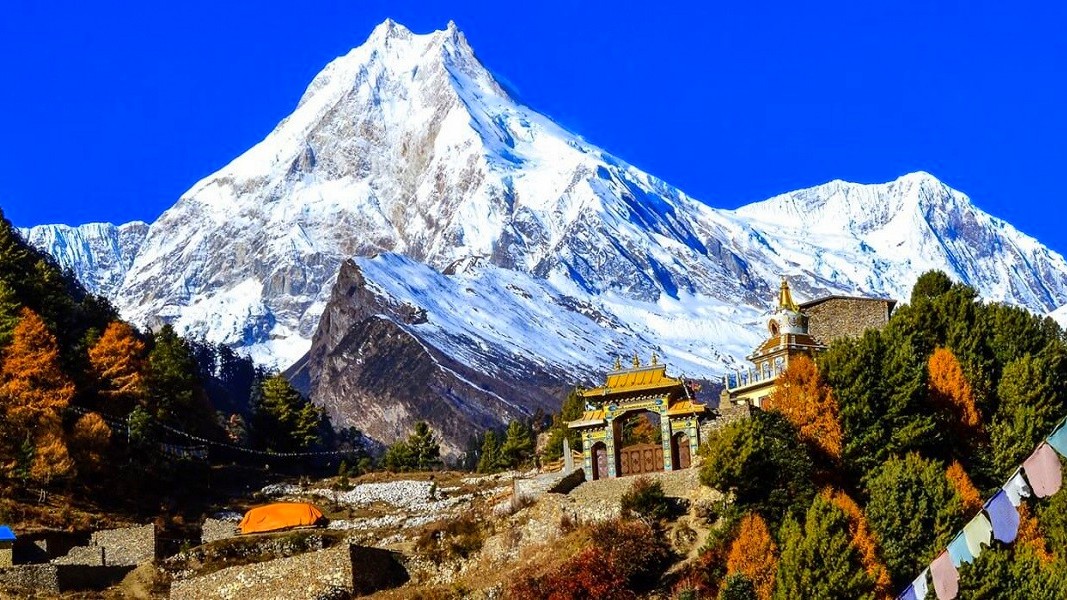
Local customs and traditions around Manaslu
The Manaslu region is home to rich Buddhist traditions that have thrived for centuries. As we trek through this sacred landscape, we encounter prayer flags fluttering in the mountain breeze, ancient monasteries perched on hillsides, and mani walls inscribed with Buddhist mantras.
The local Gurung and Tibetan communities maintain distinctive cultural practices that have remained largely unchanged for generations. During our expeditions, we often witness traditional festivals where locals perform vibrant dances in colorful attire, sharing their heritage through music and movement.
One of the most touching traditions we've experienced is the warm welcome ceremony where villagers offer chang (local barley beer) and khata (ceremonial scarves) to visitors as a sign of respect and goodwill.
Interacting respectfully with local communities
We believe meaningful connections with local communities enrich the expedition experience. When visiting villages, we encourage our clients to ask permission before taking photographs, dress modestly, and learn a few basic Nepali phrases.
Small gestures go a long way - removing shoes before entering homes and monasteries, walking clockwise around religious monuments, and never pointing the soles of your feet toward people or sacred objects.
Our team members often serve as cultural bridges, helping our clients understand appropriate behavior while facilitating genuine interactions with locals. We've found that sharing meals with families creates lasting memories and deeper understanding of mountain life.
Our commitment to sustainable mountaineering
The majestic Manaslu deserves our utmost respect and protection. We've implemented comprehensive sustainability practices across all our expeditions to minimize environmental impact.
We strictly limit group sizes to reduce trail erosion and overcrowding. All our camps are set up with environmental protection in mind, using energy-efficient equipment and solar chargers whenever possible.
Perhaps most importantly, we pay fair wages to our local staff and porters, ensuring tourism benefits flow directly to the communities that call Manaslu home. We also contribute a portion of our expedition fees to local conservation initiatives focused on preserving this pristine wilderness.
Leave No Trace principles in practice
We don't just talk about Leave No Trace - we live it on every expedition. From day one, we brief all team members on proper waste management, including carrying out all non-biodegradable trash (yes, even toilet paper!).
Our camp kitchens use eco-friendly cleaning products, and we carefully manage all wastewater. We strictly avoid single-use plastics by providing water purification systems and reusable containers.
On the mountain, we stay on established trails to prevent damage to fragile alpine vegetation. We never pick plants or disturb wildlife, understanding that we're privileged guests in their home.
At Everest Sherpa Expeditions, these aren't just policies - they're deeply held values. We've seen firsthand how responsible tourism practices can help preserve these sacred mountains for generations to come.
Standing at the world's eighth highest peak, Mount Manaslu offers adventurers an extraordinary expedition experience that combines technical climbing challenges with rich cultural immersion. Through Everest Sherpa Expeditions' expert guidance, climbers receive comprehensive support throughout their journey, from obtaining necessary permits to navigating the classic route with experienced Sherpa guides. Proper preparation, including physical conditioning and acclimatization, remains crucial for success on this 8,163-meter giant.
The Manaslu expedition represents more than just a mountaineering achievement—it's an opportunity to experience Nepal's diverse cultures while practicing responsible tourism. Whether you choose the popular pre-monsoon or post-monsoon seasons for your climb, this adventure promises breathtaking landscapes and personal transformation. Ready to take on this majestic peak? Contact Everest Sherpa Expeditions today and begin your journey to the "Mountain of the Spirit."
If you need any further information, please contact us by email: [email protected], Phone: +977- 980 195 6248 (WhatsApp).

